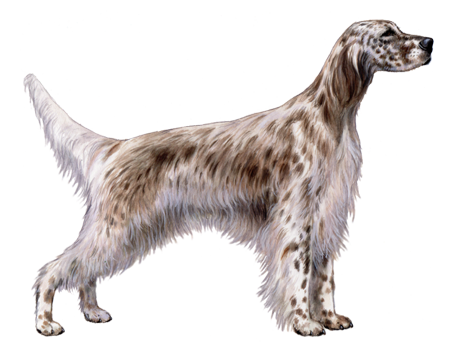
Alpine Dachsbracke
Alpine Dachsbrackes are active, loyal dogs with keen hunting instincts. Their fearlessness and intelligence make them great working dogs. But it's their friendly nature that wins people over when choosing their ideal furry friend.
Interested in discovering if your dog is an Alpine Dachsbracke?
Check out Wisdom Panel's DNA tests.

Alpine Dachsbracke Traits
General Appearance
The Alpine Dachsbracke is a medium-sized hunting dog with a sturdy build and strong muscles.
Coat and Coloring
The breed has a close-fitting double coat made of a thick topcoat and dense undercoat. The ideal color is a dark "deer" red, with or without black hairs. It's also acceptable for Alpine Dachsbrackes to have a black coat with clearly defined red-brown markings on the head, chest, legs, feet, and underside of the tail.
Distinctive Physical Traits
Alpine Dachsbrackes have a noticeable furrow in their foreheads, broad hanging ears, elongated bodies, and short, strong legs.
Alpine Dachsbracke Temperament
Though bred for hunting, Alpine Dachsbrackes enjoy the companionship of people and other dogs. They're friendly, easygoing pups that get along well with kids.
Because of their strong prey drive, Alpine Dachsbrackes may chase cats or other small pets. They also love to follow a scent, so it's essential to have a fenced yard to prevent them from wandering off.


Alpine Dachsbracke History
Originating from Austria, the Alpine Dachsbracke is a hound with some impressive royal lineage. As the story goes, Crown Prince Rudolf of Habsburg took hunting trips to the Middle East in the late 1800s. On these trips, he required his gamekeepers to bring a dog that appeared to be very similar to (if not actually) the Alpine Dachsbracke.
These dogs descended from an ancient hunting breed. Hunters used them as tracking dogs for wounded deer and as scent hounds for fox and hare. Their short stature and longer ears made them highly efficient at following a trail—even when the scent has gone cold. And as their name suggests, they also performed well at high altitude.
Austria recognized the Alpine Dachsbracke in 1932, and the FCI accepted it as a Scenthound in 1991. Five years later, the United Kennel Club recognized the breed.
Alpine Dachsbracke Care
Nutrition
Alpine Dachsbrackes require a diet formulated for their life stage (e.g., puppy, adult, senior). A food made specifically for medium-sized breeds should have the appropriate blend of nutrients.
You may need to adjust how much you feed, depending on your pup's daily activity level. A dog that hunts all day will require more calories than one that spends most of the day lounging around the house.
Grooming
Most of the time, weekly brushing is enough to keep the Alpine Dachsbracke's coat free of loose hair and dirt. However, these dogs do blow their coats a couple of times a year. You'll likely need to brush more frequently during these seasonal shedding periods to keep the hair from overtaking your home.
Be sure to round out your pup's routine care with nail trims, ear cleanings, and a dental hygiene program that includes at-home teeth brushing and professional dental cleanings.
Exercise
Alpine Dachsbrackes are active dogs that need plenty of regular exercise. True to their hound dog heritage, they love hunting and tracking. But long walks, running around the backyard, and hikes in the country with their people are other great ways for them to burn off some energy.
Training
This intelligent breed is very trainable—as long as you hold their attention. So, keep training sessions short and engaging, and use positive reinforcement to reward desired behaviors.
Like all dogs, Alpine Dachsbrackes also benefit from early socialization. Introducing your pup to different people and situations when they're young will help them become a well-adjusted adult dog.

Alpine Dachsbracke Genetic Health Conditions
-
Chondrodystrophy (CDDY) and Intervertebral Disc Disease (IVDD) Risk
Chondrodystrophy (CDDY) is a skeletal disorder characterized by shortened limbs and abnormal early degeneration of the spinal discs, or intervertebral disc disease (IVDD), which predisposes to disc herniation.
-
Hyperuricosuria
Hyperuricosuria (HUU) is a condition that predisposes affected dogs to the formation of urinary stones, such as kidney or bladder stones.
-
Neuronal Ceroid Lipofuscinosis 8 (Discovered in the Alpine Dachsbracke)
Neuronal Ceroid Lipofuscinosis 8 (NCL8) is a progressive disease causing uncoordinated movements, behavioral changes, vision loss, and epileptic seizures.
Knowing if your Alpine Dachsbracke is a carrier or at-risk for these conditions can help you and your veterinarian plan for your pup’s lifelong care. With Wisdom Panel™ Premium, you can get results for over 200 genetic health tests.
Breed Group
Sporting
The sporting group breeds are incredibly diverse in personality and appearance, but can be characterized as very sturdy. They were developed to work closely with people and in general have a very responsive nature and high intelligence.
Resources
http://www.fci.be/Nomenclature/Standards/254g06-en.pdf
https://www.eukanuba.co.uk/breeds/alpine-dachsbracke-(alpine-basset-hound)#breed-good-to-know
Reviewed September 5, 2020 by Laura Inman, DVM





































































